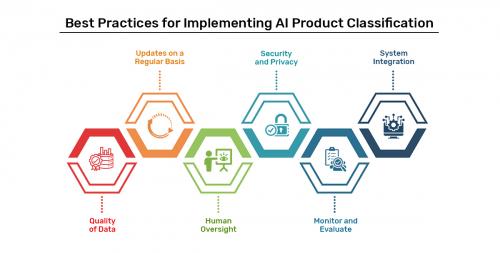AI Product Classification: Save Time and Enhance Accuracy

AI Product classification permits retailers to rely on machine learning for analyzing vast repositories of product categorization data which are present for implementing and perfecting the same. Understanding what it entails, how it can be best implemented in your business, and its inherant benefits are discussed in this blog.
Product classification is a critical function of any e-Commerce business and entails categorization of products as per their key attributes; size, color, and material. Since manual classification of products takes up a lot of time and is fraught with errors, artificial intelligence (AI) acts as a key catalyst here.
So, let’s now dive in to see what AI product classification entails and how it assists eCommerce businesses in saving time and improving accuracy.
Machine Learning Algorithms
Machine learning algorithms are undoubtedly the most efficient method for boosting product classification using AI. The algorithms are able to learn from prevailing product data and utilize that knowledge to classify new products instantly. For instance, an algorithm can gather that there are a particular class of attributes linked to a particular product category like shoes and then utilize that knowledge to instantly classify new shoes based on those attributes.
Training your AI Models
Getting the most out of your AI for product classification involves training your AI model on a vast and varied range of datasets which include product images, descriptions, as well as other attributes. The greater the data your AI models need to learn from, the greater will be its accuracy in classifying products.
Natural Language Processing (NLP)
NLP helps in improving product classification through analysis and know-how of text-based product descriptions. The utilization of NLP can assist AI in instantly extracting key product features from product descriptions and utilizing them for classifying products in a much more accurate manner.
Image Recognition
A robust and key technology that can be utilized in boosting product classification is image recognition. AI analysis product images instantaneously to spot product features like color, shape, and pattern. This assists in enhancing the accuracy of product classification and reducing the need for manual intervention.
Ecommerce Platform Integration
Deriving the maximum from AI for product classification involves integrating it with your eCommerce platform. This assits in automating the classification process and limiting the requirement for intervening manually. For instance, a product classification system backed by AI can intantly organize new products into categories as and when they are introduced to your eCommerce platform leading to time saving and enhancing accuracy.
Advantages of AI in Product Classification
1. Ensures Correct Product Mapping: Correct product mapping involves the creation of organized product groups which implies formation of macro-categories and micro-categories which lie under the main category. AI-backed product classification ensures precise macro and micro categorization predictions which are based on category ID and taxonomy tags. It helps in preventing expensive errors incurred manually.
2. Optimizatoin of Tariff Classification and Customs Compliance: Mass volumes of products from several countries and retailers leave plenty scope for error. An AI-based system can utilize data like manufacturer, product description, and other input to instantly ensure customized classification and accurate tariff codes.
3. Product Recommendation as Per Previous Customer Experience: AI assists in recommending new products as per customer’s previous browsing and purchase history. As of date, customers have a need for personalized content and special offers based on their personal preferences. AI categorization offers actionable insights enabling individual message delivery. This tool is utilized by big businesses including Netflix and Spotify.
4. Correlating Critical Data of Various Classes: Apart from matching data with a given class, AI techniques permit correlation of data from various classes that share association. Meta-data analysis is integrated with machine learning for attaining an in-depth understanding of the data. This allows for automatic cataloging for easy discovery via search. Through a combination of in-depth classification and correlation, AI offers enterprises with tools for locating, inventoring and mapping critical data.
Best Practices for Implementing AI Product Classification
1. Quality of Data: The data used for training and testing your AI models must be of high quality since the output quality directly correlates to input quality.
2. Updates on a Regular Basis: Constantly update your AI models for adapting to change in prodcut catalogs and customer choices.
3. Human Oversight: Even though AI is key in automating most of the classification process, human oversight is critical for quality control and addressing edge cases.
4. Security and Privacy: Compliance with data privacy regulations is necessary for protecting user data and sensitive information.
5. Monitor and Evaluate: Monitor the performance of your AI classification system on a regular basis and make changes as and where required.
6. System Integration: Ensure a seamless shopping experience by integrating your AI classification system with other e-commerce systems.
Advertise on APSense
This advertising space is available.
Post Your Ad Here
Post Your Ad Here
Comments